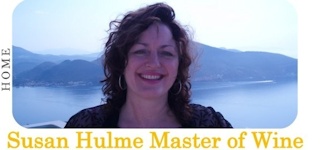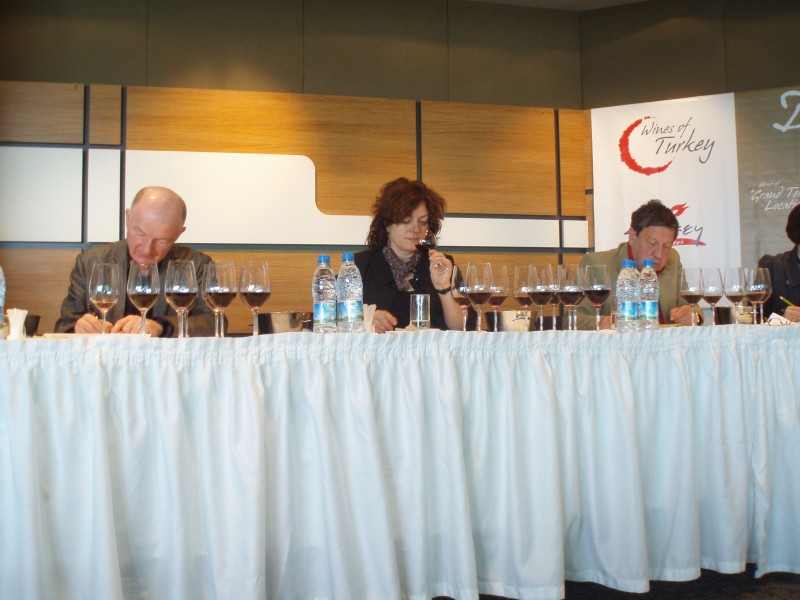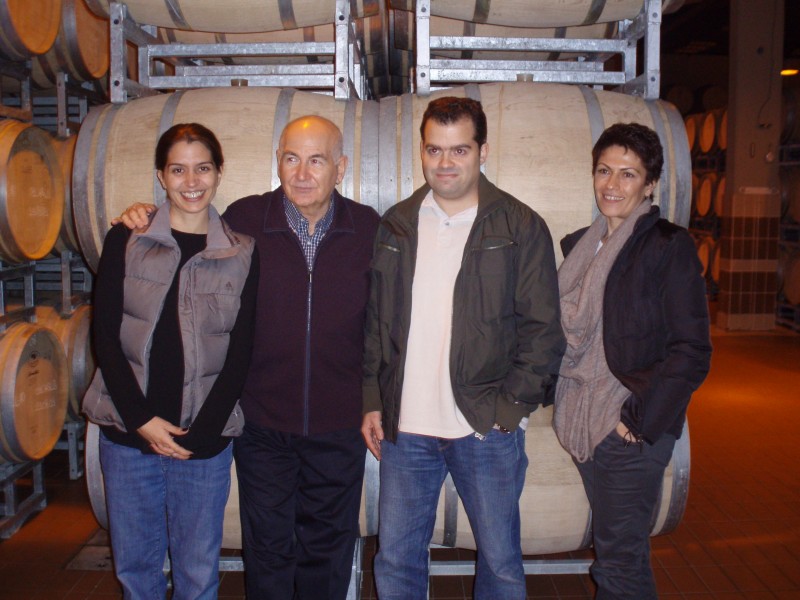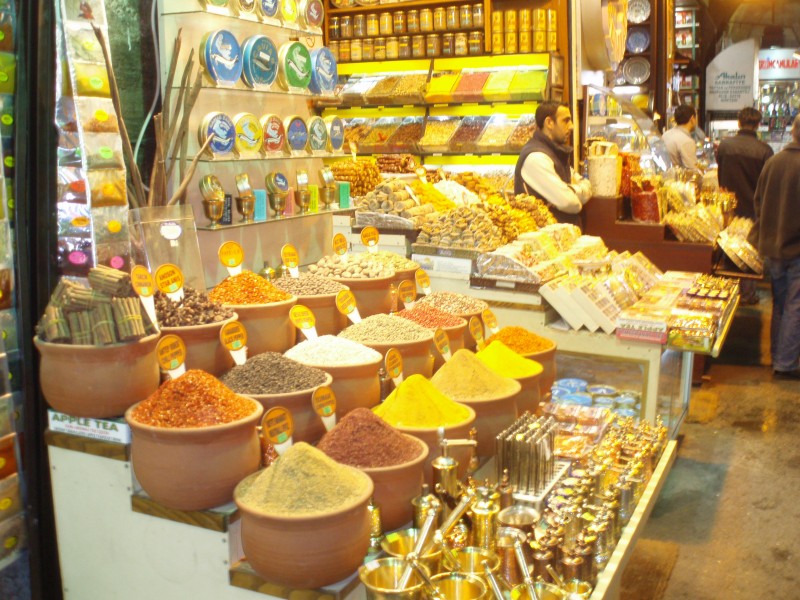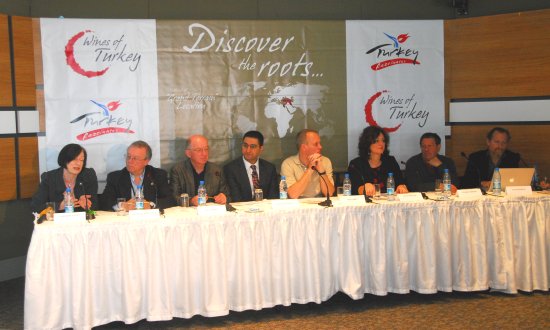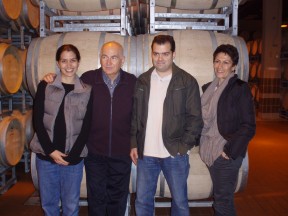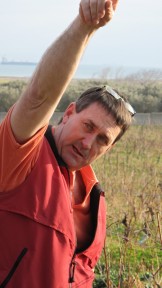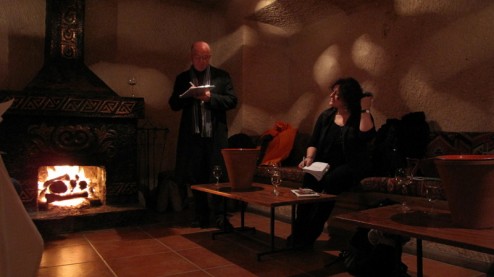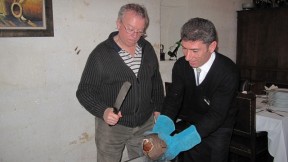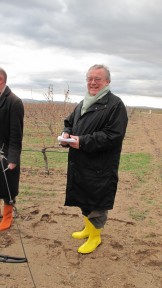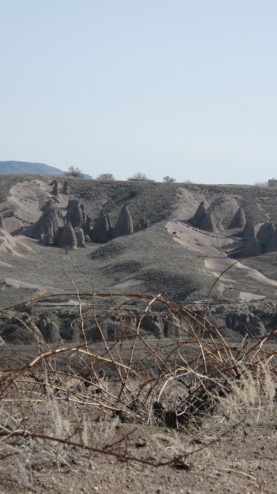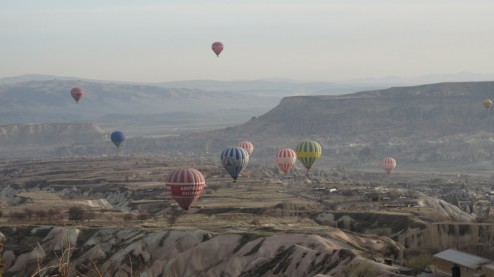A press trip to visit the wine regions of Turkey in spring sounded like an exciting idea back in the middle of a bleak December and I still felt excited as we were about to depart on the last day of February 2010. I’d even done some homework and tasted a bottle of Kavaklidere Öküzgözü from a local Turkish restaurant/deli.
The five day trip was organised by Wines of Turkey, an organisation set up only in the last 3 years by Taner Öğütoğlu and his wife and funded by a small monthly contribution from five of the main wineries. Their first initiative was two years ago when they hired a stand at the LIWSTF and several of the producers came over to represent their wines.
On the first full day we were given a thorough presentation on Turkish grape varieties and key wine regions by Daniel O’Donnel of Kayra. We had a big blind tasting of 49 wines representing 16 wineries; we were to assess and give marks for the wines. This was a bit of a shock to the system as we were unfamiliar with the grapes and their characteristics. We were also being filmed for every second of the tasting – most of the producers were watching us on a big screen situated outside the tasting room.
It was quite a mammoth tasting as a first introduction to Turkish wines but it gave me a great overview of the quality and styles. By the end things were running late and I felt sorry that we didn’t have longer to talk more to the winemakers and to taste more of their wines during the walk-around tasting in the afternoon.
What it did give us was an overview of wine styles:
- 12 white (a mix of native white varieties (Emir and Narince), Sauvignon Blanc and Chardonnay.
- 3 rosés (one blend, and two native varieties (Kalecik Karasi and Adakarasi)
- 34 reds – these consisted of 3 Kalecik Karasi; a mixture of two more native varieties (Öküzgözü, which became my firm favourite by the end of the trip and the intriguingly characterful, tannic Boğazkere) and international varieties such as Cabernet Sauvignon, Merlot and Syrah.
That evening (as every evening) we were treated to a delightful meal with the producers in one of Istanbul’s many top quality restaurants. I was struck by how many international restaurants there were with an emphasis Turkish food with an international twist; there is a wealth of top quality chefs and beautiful restaurants in stunning locations in Istanbul which I hadn’t imagined. During pre-dinner drinks we met the British Consul in Turkey, Jessica Hand and her American ex-US army husband who both seemed passionate about living and travelling in Turkey and the beauty of the countryside.
The rest of the week involved visits to Wines of Turkey’s three major supporting wineries, Doluca in Thrace, Kavaklidere in Cappadocia and Kayra in Istanbul for a more in-depth look at what they produce and the regions themselves. While in Cappadocia we also visited the Turasan winery. What was especially well done on this trip was that the wineries, whenever possible, had organised tastings with flights of 3 or 4 of the same variety from different regions so we soon began to get a feel both for the characteristics of these varieties and the regions themselves.
Doluca
Doluca is a family-owned company based in Thrace and presided over by the eloquent Ahmet Kutman. His daughter Sibel takes care of marketing and son Ali is the winemaker (along with female Turkish winemaker Aysun Pirdel).
They were the first Turkish winery to plant international grape varieties. In 1924 Ahmet’s father went to study in Geisenheim and he founded the Doluca company in 1926 (Ataturk had recently come to power and legalised the consumption of alcohol). Before that, in 1925 he had imported varieties such as Cinsault, Riesling and Gamay to Thrace as he thought they would do well there. Later, in the mid-1940’s, these vine cuttings were sold on the market under the brand name Doluca.
Ahmet joined the company in 1969 and he studied oenology and viticulture at UC Davis, California. Production then was 150, 000 bottles and Ahmet wanted to grow and expand the company. Turkey in the mid-1960’s was going through double and triple inflation but also the tourists had discovered Turkey; this was to prove very important for wine consumption. When Ahmet became chairman in 1981, he abandoned his concrete tanks in favour of temperature controlled stainless steel tanks and introduced state-of-the-art bottling lines with inert gas fillers. More recent investment has focused on the vineyards and with a friend they developed a joint brand called Sarafin on the Gallipoli peninsula. They now own vineyards in Gallipoli and Deznir in the south-west of Turkey. They have an Australian consultant who has encouraged them to do much more micro-management of the vineyards as there is so much variation just within a single vineyard.
Alçıtepe
One exciting development is their single vineyard in Gallipoli called Alçıtepe, planted in 2001 with Shiraz, Grenache, Cabernet Sauvignon and Öküzgözü at an altitude of 200-300m; the soil is loamy with grainy sand. I had given their Doluca Grenache a high score in the blind tasting and so was very interested to see where it had come from. But distances are great in Turkey and we had driven for 3 ½ hours from Istanbul to get to the winery in Mürefte so a further journey was out of the question but the vineyard would have been worth the journey I’m sure. Next time perhaps.
Apart from Alcitepe, they have other single vineyards focusing on other varieties:
- Eceabat – planted in 2005 with Merlot, Miskat (Muscat), Viognier
- Güney (in Denizli) – planted in 2006 with Boğazkere, Shiraz and Cabernet Sauvignon.
Their big aim is to be able to provide 50% of their own grapes by 2012. Interestingly, Doluca’s production has decreased from 11 million bottles in the 1990’s to 5 million bottles now that they focusing much more on producing high quality wines. They have decided to let go of some of the tourist hotel trade; the popularity of all-inclusive holiday packages has meant there is a demand for the cheapest wines possible regardless of quality. I really liked their trend towards individual terroir and the micro-management of the vineyards and thought it reflected very well in the progress of the wines, especially the four vintages from 2006 to 2009 of Cabernet Sauvignon/Syrah from the Alçıtepe vineyard. In 2007 the alcohol was 15.1% but by 2009 it was 14.1% with a more refined tannic structure and more distinctive cassis and blackcurrant leaf flavours. The most recent had a much better balance and elegance overall.
As we were still coming to grips with the characteristics, what really helped was tasting the wines in groups of 3 or 4 of the same variety but from different areas. It was interesting to see that the more recent plantings of Öküzgözü and Boğazkere in Denizli had a much more refined tannic structure in general but some of the flavours were being masked by expensive, high quality new oak. While on the other hand there was something more exotic and a wild beauty to the fruit in the Eastern Anatolian wines but it was masked by the wildness and rusticity of the tannins. This was partly due to poor vineyard management in this region which Doluca had no control over.
Kayra (Thrace)
We had a brief whistle stop at Kayra’s winery in Thrace where, fuelled by a desire that any long journey must be made worthwhile by visiting a vineyard, we persuaded Daniel O’Donnel, Kayra’s winemaking director (pictured left), to take us to his new Kayra vineyard. An intrepid group of myself, Caroline Gilby MW, Oz Clark and David Furer and the affable Taner jolted along for 30 minutes in the back of a tractor along a muddy track to stand in the rain and mist in a new, as yet unnamed vineyard facing Gallipoli across the sea. The other sensible half of the group were whisked around Kayra’s winery then back to Istanbul.
Still, it was unforgettable, invigorating and bracing – like the Skegness poster, and I’m glad I went. Thanks to Caroline, David and Oz for being such good sports and coming along and to Taner and especially Daniel for making it possible. On top of this we were blessed with a taxi driver with a ruthless desire to get us back to Istanbul on time. His fearless driving, tendency to take red lights as merely advisory and knowledge of back street short cuts through Istanbul was second to none. Miraculously we were back within half an hour of the others.
Back in the comfort of the Marmara Pera Hotel, we discovered one of the most spectacular views of Istanbul from the roof-top bar. The Kutman family were our hosts again at Mika Restaurant. For many of us this was the culinary highlight of the trip. It was the most delicious of all the wonderful meals we enjoyed because there was a subtlety and elegance to the food and an understated emphasis on the quality of the ingredients.
Wednesday 3rd March began with a 7.20 departure from our hotel for a flight to Nevşehir in Central Anatolia to visit the Cappadocia region, home of the Emir grape variety and world famous cave dwellings where early Christians had lived and hidden from the persecution of the Romans. Here we were due to visit two wineries, Turasan and Kavaklidere.
Turasan
Turasan is owned by Hasan Turasan and has a young French winemaker, Edouard Guérin, at the helm. I had sought them both out on Monday at the blind tasting because I very much liked their Narince 2008.
We had been told Cappadocia had a continental climate and could be very cold, especially at night. It was a cold, drizzly start to the day but there to greet us was a blazing coal fire in the traditional-style tasting room which we all gathered around to enjoy.
Turasan is a family winery, situated in Ürgüp, and was founded in 1943. One of the first things Edouard told us was that wine was not a hobby for them, they needed it to be a business – a healthy attitude I felt. He graduated from Montpellier University and started here in 2007 – he felt he could have so much more freedom and control here as a young, newly graduated winemaker than anywhere else. They work with all of the aforementioned Turkish varieties: Emir, Narince, Öküzgözü and Boğazkere. Importantly they prefer not to use too much oak because, as I had already found in the blind tasting, they felt a lot of wines were over-oaked.
The walls of the cellar were tuffeau which, as Edouard said, acts like a sponge for water. This is important in hot dry summers with low fertility soils. Vine density is low at 6000 vines per ha – the amount of water available would not support higher density plantings. There is no phylloxera here so the Emir wines we tasted were from vines grown on their own roots.
The vineyard altitude varies between 1000 – 1500 metres. This year they had snow here on the 30th September (2009) so they can’t grow varieties like Boğazkere which has a long slow vegetative period. On the other hand, this gives big diurnal differences of temperature which of course helps retain acidity and flavours.
Edouard has some flexibility when making Emir, depending on the vintage. In 2007 in July, the temperature here was 55o C (130o F – Iraqi desert temperature) so he used grapes planted at 1500 metres to retain acidity and flavours. Here the soils are very rich in potassium and calcium so the grapes lose lots of tartaric acid; most of the acidity therefore comes from malic acid. As Emir flavours and aromas are reminiscent of fresh green apples the malic acid accentuates the impression.
The most characterful and traditional lunch of the whole trip followed which I enjoyed immensely. Charles was first up to crack the neck of a clay pot with a sword-like knife so that casseroled meat spilled out (pictured right).
He did it with one fell swoop – my attempt was a bit less impressive and took 2 or 3 hits. We had traditional meze, a fresh salad, local cheeses followed by meat with delicious rice.
As we entered the restaurant I noticed some lived-in houses built into the traditional rock dwellings and was surprised when Edouard told me they sell for $150, 000 just for an empty shell without electricity and are highly sought after as homes. Wish I’d bought a cave or two before they caught on!
Kavaklidere
Our next visit was to one of the big wineries, Kavaklidere, who we had just learned had come out top of the blind tasting overall. Caroline, Charles and I had given the Kavaklidere Öküzgözü 2008 our top marks. The Kavaklidere team who met us included the owner, Ali Basman, and the delightful Turkish female winemaker Asli Odman Gider, who had studied in Bordeaux. They were highly organised and had even gone to the trouble of providing brightly coloured wellington boots (see Charles pictured left) in various sizes in order for us to go out and visit their Côtes d’Avanos vineyard which was was planted in 1993 at an altitude of 950m.
Avanos translates as red and is the name of a nearby river. The soil is volcanic tufa, very highly drained with a layer of pebbles. They train the Narince and Chardonnay using the Gobelet system so that they can cover the roots with earth as frost protection. They can get temperatures of -17oC in winter and hot summers of 40oC; night temperatures in summer fall to between 20 and 25oC giving a diurnal difference of between 15 and 20oC.
The visit in this case was cut short by heavy rain so we trooped back in our jeeps to the winery for a very professionally laid-out wine tasting. There was a full scale map of Turkey with the wine regions set out in front of us so that we could begin to get more to grips with where these wines came from. The Kavaklidere wines were not heavily-oaked compared to some other wines in the blind tasting; neither were they over-extracted.
Some winemakers seem determined to take out their wine ambitions on the grapes themselves, especially during the maceration and extraction process by squeezing every last drop out of the grapes, the result being that, in the glass, their wines lack charm and grace. This is not just a Turkish phenomenon and is common in many more well-known wine regions. The Kavaklidere wines instead had a gentleness of touch which allowed some of the beauty of the fruit and fragrance to come out, not only with the Öküzgözü but even with the wilder Boğazkere. It is often said that the personality of the winemaker comes out in the wines and this seemed to be the case with Asli. She was so attentive to detail, patient and willing to listen while being finely-tuned to what was going on around her. These are ideal qualities for a winemaker.
The following day we were taken to one of the most impressive and unusual vineyards I have ever seen – a very old vine Emir vineyard called Çat (meaning crossroads, as it was a crossroads for the old silk route), with vines between 70 and 150 years old, surrounded by the dramatic Cappadocia landscape (pictured right). No other vines can grow here because of the winter and spring frosts and they are grown on their own rootstocks hence their longevity.
The first blinding sunlight of the trip reflected off the chalky/volcanic soils and the snow-covered mountain of Hasan Dag in the distance. I was so glad I had made the effort to get up and visit this vineyard as it was a real wrench to leave the fabulous hotel we were staying at.
Museum Hotel
Our overnight stay in the Museum Hotel (www.museum-hotel.com) in Uçhisar/Nevşehir was definitely the non-wine highlight of the trip for me and I would recommend it to anyone looking for a romantic and authentic place to stay. It is carved into the mountain side in the manner of the traditional cave dwellings but is decorated with the most lavish ethnic furnishings, carpets, rugs and antiques.
The owner is a collector of beautiful and historically significant carpets and showed us one or two of his special rugs on display. My room was on two levels and had a jacuzzi and shower, an enormous 4 poster bed and a fish pond complete with fountain and black and gold goldfish. The room had several windows and I awoke just after dawn to the sight of 18 or so hot air balloons rising slowly above the magical Cappadocian landscape (pictured below). I am a bit of a connoisseur of hotels – this was one of the top five hotels I have ever stayed in for the beauty of the location and the luxury of the room. I must give special thanks to Ceyda at Redmint Communications and the owner of the Museum Hotel for this wonderful overnight stay.
After flying back to Istanbul, we had our final visit to Kayra winery for a comprehensive tasting with the ebullient and highly enthusiastic Daniel O’Donnell and his team. Kayra have been so forward-looking in opening a very successful wine school and when we arrived, AWE member Kevin Powell was there delivering a WSET Advanced course on behalf of the WSET.
First we tasted some local, inexpensive Turkish wines to give us a feel for what was out there at the cheap and not so cheerful end. There were 6 or 7 wines but two of these were enough for me to get an idea. The 50 or so Kayra wines we tasted ranged from the latest tank samples of Chardonnay to many of the major Kayra brands. It once again highlighted the regional variations for Öküzgözü and Boğazkere between Central-Eastern Anatolia and the Aegean. We also tasted a wine which held some sentimental value for Tim Atkin MW – the famous Turkish brand, Buzbağ, which he remembered from his student days. It was a marathon tasting at times done at breakneck speed in that macho ‘I can taste faster than you’ mode but still interesting nevertheless. Our final dinner was hosted very generously by Kayra at their restaurant and included members of the Turkish press and PR agencies as well as the Kayra team.
Final impressions
The following day we had a press conference to report on our impressions to the Turkish media and to the producers themselves. I think all of us found more to admire than we had expected. Turkish wine is at an exciting stage – it has a wealth of high quality and fascinating native grape varieties, some very committed producers who can call on the experience of outside consultants and now they have Wines of Turkey to promote them.
Of course there are barriers to success: in Turkey there are prohibitively high taxes on wine which tend to make the better wines exclusive and over-priced; the pronunciation of the names of the indigenous grape varieties is a big challenge and it took most of us nearly a week to learn to pronounce them correctly (but isn’t that true of some other countries and there is no reason why brand names cannot be promoted instead).
On the positive side, Turkey was the biggest tourist destination for the UK last year and we tend to have a positive image of the country. I would like to see one of the supermarkets or retail chains start to sell some of these wines to see what happens. Why not dare to be different and lead the market for a change?
We started the week not knowing much about Turkish wines and ended it by all of us having a great enthusiasm for several of the native Turkish grapes and a knowledge of some of the wine regions and key producers. We also had a few glimpses into the beauty and exoticism of Istanbul and Cappadocia and the depths of Turkish hospitality.
Pictured L-R: Oz Clark, Dr. Caroline Gilby MW, Stephen Brook, Susan Hulme MW, Taner Öğütoğlu (Wines of Turkey), Charles Metcalfe, Tim Atkin MW, Dr. Aysegul Gurgezoglu (Turkish Tourist Board), Ceyda Pekenc (Redmint Communications), David Furer.
With grateful thanks to the Turkish wine producers, Wines of Turkey, Redmint Communications and the Turkish Tourist Board for their part in organising this trip.
Photos (from top):
Panel (seated) © Ceyda Pekenc, Redmint Communications; the Doluca family © Susan Hulme MW; Daniel O’Donnel, Oz and Susan at Turasan, Charles with sword, Charles with yellow boots, Çat vineyard, Cappadocian balloons © Caroline Gilby MW; panel (standing) © Ceyda Pekenc, Redmint Communications
© 2010 – 2014, Susan Hulme MW. All rights reserved.
